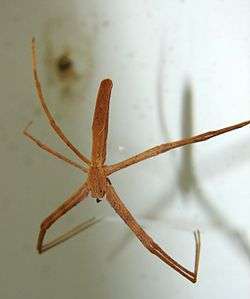Deinopis
| Deinopis | |
|---|---|
 | |
| Deinopis subrufa | |
| Scientific classification | |
| Kingdom: | Animalia |
| Phylum: | Arthropoda |
| Class: | Arachnida |
| Order: | Araneae |
| Suborder: | Araneomorphae |
| Family: | Deinopidae |
| Genus: | Deinopis Macleay, 1839 |
| Species | |
|
D. longipes | |
| Diversity | |
| 46 species | |
| Synonyms[1] | |
|
Dinopsis Macleay, 1839 – orthographic variant | |
Deinopis is a genus of spiders known as net-casting spiders, gladiator spiders and ogre-faced spiders.[2] Its distribution is widely tropical and subtropical. They catch their prey using a specially spun "net".
Name
The genus name is derived from the Greek deinos "fearful" and opis "appearance"; see also the family name "ogre-faced" spiders.
The spelling Dinopis is also found, but this is regarded as "an unjustified emendation".[1]
Net-casting
Spiders in the genus Deinopis catch their prey in an unusual fashion. They first spin a small upright rectangular cribellate web. This is then detached from its supporting threads and held horizontally above the ground by the spider's long front two pairs of legs while the spider hangs almost vertically. Passing prey is then captured by dropping the "net" over it.[2]
Eyes
The two posterior median eyes are enlarged and forward-facing, with compound lenses. These eyes have a wide field of view and are able to gather available light more efficiently than the eyes of cats and owls. This is despite the fact that they lack a reflective layer (tapetum lucidum); instead, each night a large area of light sensitive membrane is manufactured within the eyes, and since arachnid eyes do not have irises, it is rapidly destroyed again at dawn. To aid further in netting prey, the spider places white fecal spots on the surface below the net and uses them for aiming.[3]
Species
- Deinopis amica Schiapelli & Gerschman, 1957 (Argentina)
- Deinopis anchietae Brito Capello, 1867 (West Africa, Angola)
- Deinopis armaticeps Mello-Leitão, 1925 (Brazil)
- Deinopis aruensis Roewer, 1938 (Aru Islands)
- Deinopis aspectans Pocock, 1899 (Cameroon, Congo basin)
- Deinopis aurita F. O. P-Cambridge, 1902 (Mexico)
- Deinopis biaculeata Simon, 1906 (Brazil)
- Deinopis bituberculata Franganillo, 1930 (Cuba)
- Deinopis bucculenta Schenkel, 1953 (Venezuela)
- Deinopis camela Thorell, 1881 (New Guinea)
- Deinopis celebensis Merian, 1911 (Sulawesi)
- Deinopis cornigera Gerstäcker, 1873 (East Africa)
- Deinopis cylindracea C. L. Koch, 1846 (Colombia)
- Deinopis cylindrica Pocock, 1898 (South Africa)
- Deinopis diabolica Kraus, 1956 (El Salvador)
- Deinopis fasciata L. Koch, 1879 (Queensland)
- Deinopis fasciculigera Simon, 1909 (Vietnam)
- Deinopis fastigata Simon, 1906 (Brazil)
- Deinopis giltayi Lessert, 1930 (Congo)
- Deinopis goalparaensis Tikader & Malhotra, 1978 (India)
- Deinopis granadensis Keyserling, 1879 (Colombia)
- Deinopis guasca Mello-Leitão, 1943 (Brazil)
- Deinopis guianensis Taczanowski, 1874 (French Guiana)
- Deinopis guineensis Berland & Millot, 1940 (Guinea)
- Deinopis kollari Doleschall, 1859 (Myanmar, Malaysia)
- Deinopis lamia Macleay, 1839 (Cuba, Puerto Rico)
- Deinopis liukuensis Yin, Griswold & Yan, 2002 (China)
- Deinopis longipalpula Strand, 1913 (Central Africa)
- Deinopis longipes F. O. P.-Cambridge, 1902 (Mexico to Panama)
- Deinopis madagascariensis Lenz, 1886 (Madagascar)
- Deinopis mediocris Kulczynski, 1908 (New Guinea)
- Deinopis ornata Pocock, 1902 (Ethiopia)
- Deinopis pallida Mello-Leitão, 1939 (Brazil)
- Deinopis pardalis Simon, 1906 (Brazil)
- Deinopis plurituberculata Mello-Leitão, 1925 (Brazil)
- Deinopis ravida L. Koch, 1879 (Queensland)
- Deinopis reticulata (Rainbow, 1899) (New Guinea)
- Deinopis rodophthalma Mello-Leitão, 1939 (Brazil)
- Deinopis schomburgki Karsch, 1878 (South Australia)
- Deinopis schoutedeni Giltay, 1929 (Congo)
- Deinopis seriata Simon, 1906 (Brazil)
- Deinopis spinosa Marx, 1889 (United States, St. Vincent, Venezuela)
- Deinopis subrufa L. Koch, 1879 (Queensland, New South Wales, Tasmania)
- Deinopis tabida L. Koch, 1879 (Queensland)
- Deinopis tuboculata Franganillo, 1926 (Cuba)
- Deinopis unicolor L. Koch, 1879 (Western Australia)
References
- 1 2 "Gen. Deinopis MacLeay, 1839", World Spider Catalog, Natural History Museum Bern, retrieved 2015-09-28
- 1 2 Leong, T.M. & Foo, S.K. (2009), "An encounter with the net-casting spider, Deinopis species in Singapore (Araneae: Deinopidae)" (PDF), Nature in Singapore, 2: 247–255, retrieved 2015-09-28
- ↑ "How spiders see the world". Australian Museum. 2015-10-30. Retrieved 2016-09-07.